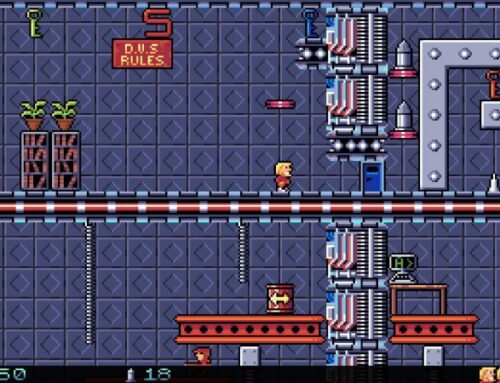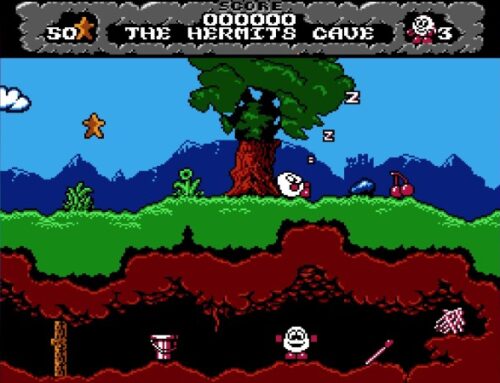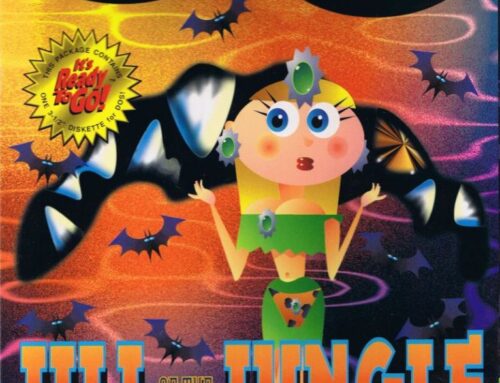We all love a list, so every Tuesday we’re posting one, on a variety of retro-themed topics! Feel free to share your own favourites down below — and let us know what other lists you’d like to see on future Tuesdays!
One of the most sadly missed aspects of retro gaming is that monthly trip down the newsagents to pick up a copy of your favourite games magazine. There were a wide variety of titles available, covering all manner of different topics — ranging from the biggest names in console gaming to the most fascinating and implausible things the international scene was promising at some indefinite point in the future.
Sure, these days we still have websites like Retrounite as well as a few remaining physical publications like the long-lived and consistently excellent Retro Gamer — but it’s hard not to feel a sense of loss when thinking back to the wide variety of game magazines we once had on offer.
So let’s think back on some of our favourites! As always, this is anything but a definitive list — and there will most certainly be author bias in this list more than perhaps any other 10 of the Best Tuesdays so far — so please do feel free to share your own favourites down in the comments or via the usual social channels!
Let’s get started!

Page 6/New Atari User
It would be remiss of me not to mention this one, likely the least well-known on the list, because it is because of Page 6 Magazine (which later became New Atari User after merging with Database Publications’ Atari User) that I am sitting here writing this right now.
Page 6 was an Atari enthusiasts’ magazine that began its life as a newsletter for a Birmingham-based Atari 8-bit users club, but subsequently expanded to national distribution and eventually a well-deserved place on national newsstands. Later in its life, it returned to being a subscription-only publication and eventually quietly died with a whimper as an A5-format zine — but it lasted longer than pretty much any other 8-bit micro magazine in the UK, all told, with its final issue showing up in 1998, some 16 years after its first publication.
Page 6 always made a point of showing that there was more you could do with both an Atari 8-bit or a 16-bit Atari ST than just playing games, and to that end incorporated a variety of interesting articles, type-in listings and programming tutorials as well as simple reviews — and that’s one of the things that always made it stand out.
My father, my brother and I all got our start in writing about computers and video games thanks to Page 6. Since the magazine covered all aspects of computing, not just gaming, my Dad mainly focused on productivity, educational and music software — plus a longstanding enthusiasm for flight simulations — while my brother and I wrote about the hottest (and lamest) new Atari ST games to hit store shelves every issue.
It’s sadly missed, but a near-complete archive of the magazine’s run can be found as PDFs over on Atarimania.

Computer & Video Games
Computer & Video Games (later CVG) was another longstanding part of the UK games press, beginning as a multi-format games magazine for 8-bit home computers and surviving until 2004; meanwhile, its website ran from 1999 until 2015, making it the longest-running video game media brand in the world.
When Computer & Video Games first launched, it was the world’s first magazine dedicated entirely to video games. Other magazines, such as the aforementioned Page 6 and other magazines like it, tended to cover the broad range of things it was possible to do with a home computer, whereas Computer & Video Games acknowledged that there was a significant market of readers who wanted to read about nothing but games.
Computer & Video Games evolved as time passed and the games industry likewise underwent some significant changes thanks to the rise in popularity of home consoles and the more widespread acceptance of gaming as part of mainstream — not just “nerdy” — popular culture.
A selection of digital Computer & Video Games issues can be found on The Internet Archive.

Advanced Computer Entertainment (ACE)
ACE remains one of my favourite retro games magazines to return to today, because each and every issue is a wonderful snapshot of what was going on in worldwide video gaming culture at a very specific moment in time.
ACE was a multiformat games magazine, but unlike Computer & Video Games, it had greater ambitions than simply covering the things that were readily accessible to the UK readership. It was noteworthy for frequently reporting on overseas happenings — it was the first place I ever read about the PC Engine, for example — and also for fascinating semi-speculative features that explore what the future might hold for gaming based on what was, at the time, bleeding-edge technology.
It’s particularly fascinating to see features on studios like Pixar long before they shot to stardom with Toy Story, and the inevitable pondering about virtual reality. Plus it’s probably the only place you would have been able to read extensive preview coverage of the sadly never-to-release Konix Multisystem — yes, the one that came with a moving chair.
Most of ACE’s run is archived as PDFs over at Atarimania.

Games-X
When my brother was 18 years old, he was all set to go to university — but he had some doubts. Having very much enjoyed his time writing for Page 6, he was interested to see if it was possible to make a career of writing about games. And thus he applied for a staff writer position on a brand new magazine at Europress — formerly Database Publications, publishers of the original Atari User — and was successful.
That magazine was Games-X, a weekly games magazine that, on its launch, cost just 60p per issue. Packing a surprising amount of information, reviews, interviews, previews and tips into each weekly issue, Games-X was a delightfully irreverent publication, and thoroughly ’90s in its overall attitude to absolutely everything.
At the same time, though, it knew that games were of increasing importance to a lot of people — especially youngsters — up and down the country, and thus it provided solid coverage on all the big releases, plus helpful information on how to get involved with the import scene. It was a fascinating experiment — if ultimately an unsustainable one due to that weekly schedule — and even had my brother not been involved with it, I would still miss it dearly.
A number of Games-X issues can be found on The Internet Archive.

Mean Machines
A longstanding favourite of many UK-based gamers, I must confess I wasn’t much of a Mean Machines reader back in the day, but it’s absolutely impossible to deny its importance to establishing the UK games press as a force to be reckoned with in the early ’90s.
Beginning life as a console-centric section of Computer & Video Games, editor Julian Rignall and designer Gary Harrod helped establish Mean Machines as a standalone publication — initially through a 16-page test issue that is quite a collector’s item today, and subsequently through a run of 24 issues between 1990 and 1992. The magazine focused primarily on the Sega Mega Drive and Super NES consoles which were popular at the time, but also occasionally delved into PC Engine and Neo Geo games.
It was noteworthy for covering both domestic and import releases; import gaming was rather popular among Mega Drive and Super NES owners in particular, since many great games that made it to America never made that last hop across the pond to Europe. The Final Fantasy games and Chrono Trigger say hi.
After its initial run, Mean Machines was split into Mean Machines Sega and the officially endorsed Nintendo Magazine System (subsequently Nintendo Official Magazine); both did well to begin with, but never quite matched the magic of those original 24 issues.
An archive of Mean Machines issues and extras can be found at The Internet Archive.

PC Player
Another somewhat lesser-known magazine that my brother worked on, PC Player launched with the bold intention of being a magazine for grown-ups — not in the sense that it was full of tits and arse (check out Escape below for that side of things) but rather in that it focused on more complex games such as strategic titles and simulations.
It was also designed to be a high quality publication in a physical sense, too. Each issue was printed on high quality paper with a thick stock cover, giving the look and feel of a “coffee table book”. The features within were detailed and presented beautifully, and the whole thing was just a wonderfully classy publication.
Sadly, it seems that wasn’t exactly what the market was after at the time, and it folded after just 11 issues. It is sadly missed, but full, high-quality scans of the first five issues can be found on the Out of Print Archive website.

GamesMaster
With the popularity of the GamesMaster TV show, it was inevitable it would get a spin-off magazine — and in fact the GamesMaster magazine managed to last a whole lot longer than its televised counterpart, running between January 1993 and November of 2018.
For a significant period of its lifespan, it was the biggest selling multi-format games magazine in the UK, outselling the well-known (and still very much alive) Edge magazine by quite a margin. It featured reviews and previews of games, plus news, posters, contributions from readers and regular competitions.
In many ways, it was designed to be quite a community-centric magazine that was particularly friendly and appealing to teenagers, and doubtless helped pave the way for the better parts of today’s online gaming community. Indeed, the website GamesRadar was essentially the online presence of GamesMaster magazine for quite some time, and doubtless the foundation that GamesMaster laid helped considerably in getting GamesRadar up and running.
A selection of digital copies of classic GamesMaster issues can be found over on RetroCDN.

PC Zone
Offering what was, for many, the peak of irreverent ’90s and early ’00s gaming journalism, PC Zone was a games magazine that focused on MS-DOS and Windows PCs that didn’t take itself too seriously — you should expect nothing less from a publication which boasted Charlie Brooker on its staff. Yes, that Charlie Brooker.
Despite its irreverent tone — particularly towards French developers, who were frequently the butt of jokes from the editorial team, primarily due to their tendency to make “weird” games — PC Zone was an informative, well-produced magazine that provided varied and interesting coverage of the developing PC gaming scene — including exploring the options that the then-fledgling Internet offered for those who didn’t have a handy IPX network with which to play Quake in their office.
Fun fact: I did my Year 10 work experience placement in the PC Zone offices, and I had a fantastic time. The art editor wanted to “mother” me, which I wasn’t quite sure how to feel about at the time. I also bought a large number of Star Trek: Deep Space Nine VHS cassettes from Virgin Megastore on Oxford Street during said placement, but I feel that’s a story for another day.
A full archive of PC Zone magazines — including the cover-mounted disks in many cases — can be found here.

Escape
Hailing from the same company as PC Zone — Dennis Publications — Escape was intended to be a publication that blended the popularity of “men’s magazines” such as Maxim and FHM with the world of video games, the Internet and tech in general. And it was mostly successful at that, providing a nice balance between attractive women posing in lingerie and stuff about manly games like Quake II.
It was very much a product of its time, of course, and almost certainly wouldn’t fly today — but it was a fun diversion for a while, particularly when the staff worked on some highly creative, silly features such as attempting to work out if video games really were better than sex through the use of a heart rate monitor. (They weren’t. Bungee jumping was, though.)
Sadly, Escape doesn’t appear to be archived online anywhere — if you happen to stumble across any, please let us know!

games
Finally, we come to a magazine that, alongside GamesMaster, departed this world relatively recently — back in 2018. games launched in 2002 and passed between several different publishing houses over its lifespan — beginning with Higbury Entertainment, moving on to Imagine Publishing and finally ending up in the hands of Future Publishing for its last two years on newsstands.
launched in 2002 and passed between several different publishing houses over its lifespan — beginning with Higbury Entertainment, moving on to Imagine Publishing and finally ending up in the hands of Future Publishing for its last two years on newsstands.
games was like a marginally less pretentious Edge, in that it offered in-depth features and developer interviews but wasn’t infused without the distinct air that it thought it was better than everyone else. As a multi-format magazine, it was quite selective about what it covered, but you could count on it to provide well-reasoned criticism — and thus a games
was like a marginally less pretentious Edge, in that it offered in-depth features and developer interviews but wasn’t infused without the distinct air that it thought it was better than everyone else. As a multi-format magazine, it was quite selective about what it covered, but you could count on it to provide well-reasoned criticism — and thus a games 10 out of 10 became quite a coveted thing to strive for among developers and publishers alike.
10 out of 10 became quite a coveted thing to strive for among developers and publishers alike.
As the magazine progressed and what was once “current” in its pages passed into the realm of “retro”, it started featuring regular, visual-heavy celebrations of influential games from the past, and for its 100th issue in September of 2010, it released 100 different covers — 400 copies of each — celebrating the publication’s top 100 games of all time.
As a relatively recent departure from the world of the games press, there doesn’t seem to be a good archive of games issues online — please do correct us if you know of one!
issues online — please do correct us if you know of one!
So those are our favourites — how many of these did you read as a youngster, and how many are you going to spend some time reading now? I know my next few visits to the toilet are going to be filled with nostalgia thanks to the research for this piece…





